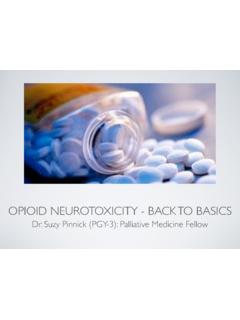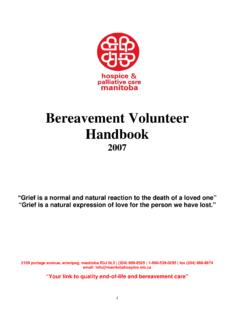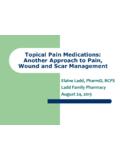Transcription of Procedure for Subcutaneous Insertion, Removal, …
1 PALLIATIVE CARE PROGRAM. Procedure for Subcutaneous insertion , removal , and medication Administration Review: April 2017. APPROVED: [June 2015]. WRHA Palliative Care Program Programme de soins palliatifs, ORSW. Procedure for Subcutaneous insertion , removal and medication Administration PART I: Establishing a Subcutaneous Site PART II: Intermittent Subcutaneous medication Administration PART III: removal of a Subcutaneous Device PART IV: Special Note Regarding Pediatric Patients and Insuflon Catheters APPENDIX A: Subcutaneous medication Compatibility APPENDIX B: Subcutaneous insertion Sites PURPOSE: To provide an evidence-based, standard approach to establishing a Subcutaneous route for medication in non-emergent situations in the home (when other routes of administration are contraindicated or unavailable.). For many palliative patients, continued use of the oral route for medication administration will not be possible at some point during the course of illness.
2 medication administration will require use of another route. The Subcutaneous route is the preferred route of administration for palliative care patients, for the following reasons: 1. Complications of use of this route (including redness, tenderness or inflammation at the insertion site, leaking needles and catheter malfunction) are rarely reported (Letizia, Shenk & Jones, 2000). 2. A small-gauge needle is only required at the time the Subcutaneous site is established, reducing the risk of needle-stick injuries, particularly with intermittent administration of Subcutaneous medications (Dawkins, Britton, Johnson, Higgins & Dean, 2000). 3. Infusions can be started and stopped with little risk to the patient of thrombosis or major bleeding (Steiner & Bruera, 1998). 4. The Subcutaneous route is relatively easy to manage in the home setting (Steiner & Bruera, 1998). Intramuscular routes of administration are not appropriate as they are painful and may be unreliable in terms of absorption.
3 Procedure for Subcutaneous insertion , removal and medication Administration procedures REVISED MARCH 2015 Page 2. WRHA Palliative Care Program Programme de soins palliatifs, ORSW. INDICATIONS: Common indications for use of the Subcutaneous route of administration of medication and / or fluids include: 1. Circumstances that preclude or compromise oral administration that may include: a. Dysphagia / difficulty swallowing due to neuromuscular weakness or mechanical obstruction b. Decreased level of consciousness / coma c. Intestinal obstruction d. Persistent nausea and / or vomiting 2. Symptom control requiring rapid and reliable medication administration and absorption. Procedure : PART I: Establishing a Subcutaneous Site: A physician's order is required prior to establishing a Subcutaneous line and prior to administering medications / fluids via the Subcutaneous line. The Subcutaneous site must be changed every seven (7) days or sooner, if necessary.
4 When changing sites, the chosen sites should be rotated to avoid using the same site repeatedly. 1. Obtain necessary equipment and supplies including: a. 1 BD Saf-T-Intima Safety System 24 gauge winged Subcut infusion device b. 2 Appropriate transparent moisture-responsive dressings c. 1 Injection Cap / End Cap d. 1 Single-use Syringe prefilled with Sodium Chloride (Normal Saline) for injection e. 1 Chlorhexidine 2% with 70% alcohol swab stick f. Clean, disposable gloves g. Sharps Disposal Container h. SUBCUT LINE Identification Label 2. Perform hand hygiene. 3. Explain Procedure and expected outcomes to patient. 4. Select an appropriate Subcutaneous insertion site (see Appendix B): Preferred Injection sites include: Upper arms Abdomen Anterior aspect of thighs Above Scapula Procedure for Subcutaneous insertion , removal and medication Administration procedures REVISED MARCH 2015 Page 3. WRHA Palliative Care Program Programme de soins palliatifs, ORSW.
5 Site should be: Easily accessible Free of lesions Away from large vessels, joints and bones Away from edematous tissue that may alter medication / fluid absorption 5. Don clean gloves. 6. Cleanse selected insertion site with the first side of the Chlorhexidine 2% with alcohol swab stick in a right to left manner (see diagram 1) for 15 seconds. Flip Chlorhexidine 2%. with alcohol swab stick over and cleanse the insertion site for 15 seconds in an up and down manner (see diagram 2). Allow the cleansed area of skin to dry for one minute or until completely dry before proceeding. Diagram 1 Diagram 2. 7. Holding the catheter as illustrated, rotate the safety barrel as shown to loosen needle inside catheter. 8. Remove protective shield from needle. 9. Using thumb and index finger to create a roll of tissue of approximately cm, bunch skin around selected insertion site. 10. Grasping and holding pebbled side of the device's wings as illustrated with bevel up and at a 45 degree angle to skin, insert the entire length of the needle into the skin.
6 Procedure for Subcutaneous insertion , removal and medication Administration procedures REVISED MARCH 2015 Page 4. WRHA Palliative Care Program Programme de soins palliatifs, ORSW. 11. If blood appears in the tubing behind wings, remove and discard the device, select new injection site and start over with new device. 12. Stabilize catheter wings, grasp safety barrel and pulling in a straight continuous motion, remove needle. Safety barrel will come off, exposing the injection cap. 13. Immediately dispose of the safety barrel containing the contaminated needle into an appropriate sharps container. 14. Remove the existing injection cap with a gentle twisting motion and attach injection / end cap. 15. Insert the prefilled syringe into the injection / end cap and gently draw plunger back to assess for blood return. If blood appears in the tubing, remove and discard the injection device, select a new injection site and start over. If no blood appears in the tubing, instill ml Normal Saline to flush the tubing.
7 16. Remove the syringe from the injection cap and discard. 17. Cover the insertion site, hub and wings with a transparent moisture-responsive dressing. 18. Loop excess tubing and secure with a transparent moisture-responsive dressing to prevent tension and possible dislodgement of the infusion device. 19. Nurse who established the Subcutaneous site writes the date of insertion , their name and signature on the green line label. 20. Complete the required documentation. Procedure for Subcutaneous insertion , removal and medication Administration procedures REVISED MARCH 2015 Page 5. WRHA Palliative Care Program Programme de soins palliatifs, ORSW. Part II: Intermittent Subcutaneous medication Administration A physician's order is required prior to administering medication / fluids via the Subcutaneous line. Note: If medications being administered are not compatible, more than one site will be required. (See Appendix A) Ensure that each site is clearly labeled as to which medication is being administered through each site.
8 1. Determine whether there is an existing Subcutaneous site, or whether one must be established. If a new site needs to be established, refer to Part I of this Procedure . 2. Obtain necessary equipment and supplies including: a. 3 Alcohol Swabs b. medication as ordered c. 1 Single-use Blunt Fill Needle for drawing medication (s). d. 1 Single-use Syringe for medication e. Sodium Chloride (Normal Saline) for injection in a single-use prefilled syringe 3. Perform hand hygiene. 4. Explain Procedure and expected outcomes to patient and family. 5. Following the physician's orders, draw up medication in a syringe and attach a syringe cap if not administering medication immediately. 6. Assess the insertion site pre and post- medication administration for: pain / tenderness, inflammation, bruising, edema, hardness, heat, exudates / leaking, discharge, itching, burning, unresolved blanching, necrosis and cannula displacement. If any of these signs and symptoms are present, change the injection site immediately.
9 7. Cleanse the injection / end cap using 2 3 alcohol swabs for a total of 30 seconds. Procedure for Subcutaneous insertion , removal and medication Administration procedures REVISED MARCH 2015 Page 6. WRHA Palliative Care Program Programme de soins palliatifs, ORSW. 8. Insert the medication syringe into the injection / end cap. To help optimize medication absorption and patient comfort, the maximum amount of medication to be administered at one time (excluding flush) is 2 mL. If the volume of medication exceeds 2 mL: o Attempt to obtain a more concentrated preparation of the ordered medication to ensure that the maximum amount of medication administered does not exceed 2 ml. If this is not possible, then: o Administer 2 ml of the ordered medication , wait 15-20 minutes. If the medication has not absorbed after this time ( presence of palpable bump . indicating incomplete absorption), decide if a second site is required for future doses and / or wait another 15-20 minutes and then administer the remainder of the medication (no more than 2 ml at one time).
10 9. Instill the ml Normal Saline flush. 10. Complete required documentation, including any adverse effects or difficulties encountered. PART III: removal of a Subcutaneous Injection Device 1. Obtain necessary equipment and supplies including: a. Clean Gloves b. 1 2x2 Gauze Pad c. Adhesive Bandage prn 2. Perform hand hygiene. 3. Explain Procedure and expected outcomes to patient and family. 4. Don clean gloves. 5. Remove green SUBCUT LINE label and transparent dressings from the existing subcut site. 6. Having 2x2 gauze dressing readily accessible, pull the Subcutaneous injection device out parallel to the skin. 7. Using 2x2 gauze apply gentle pressure over the site. 8. The insertion site may be left open to air or covered by an adhesive bandage, if required. 9. Complete required documentation in patient's medical record. Procedure for Subcutaneous insertion , removal and medication Administration procedures REVISED MARCH 2015 Page 7. WRHA Palliative Care Program Programme de soins palliatifs, ORSW.











